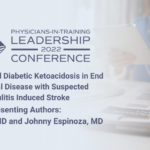Abstract | April 4, 2022
Steroid Induced Diabetic Ketoacidosis in End Stage Renal Disease with Suspected Vasculitis Induced Stroke
Learning Objectives
- Identify difficulties in the management of DKA with concomitant AKI on CKD.
Introduction: Managing diabetic ketoacidosis (DKA) in the setting of chronic kidney disease (CKD) remains a challenge. While studies have reported complications of DKA in dialysis and end stage renal disease, protocols are limited to patients with relatively persevered renal function. We present a case of managing acute stroke vasculitis with steroid induced DKA in the setting of oliguric AKI on CKD.
Case Presentation: A 71-year-old female with a history of diabetes and CKD presented to our hospital with right lower extremity weakness. Initial head CT and MRI showed chronic infarct changes in the left frontal and parietal lobe. Within 24 hours, the patient developed dysarthria with altered mentation and was transferred to the ICU. MRI angiogram was suggestive of severe vasculitis. Neurology was consulted and recommended high dose (125 mg) methylprednisolone every 6 hours. The patient’s renal function was poor on admission with and estimated GFR of 12 min/ml/SA and continued to decline. She eventually developed DKA and required maximal therapy of 17 units of insulin per hour. Further insulin increases were limited due to multiple episodes of non-sustained ventricular tachycardia (VT). Renal panel revealed potassium levels below 4.5 mEq/L. Due to her history of chronic hyperkalemia from CKD, we targeted a short-term potassium goal of 4.5 to 5.5 mEq/L with resolution of VT. We relied on ketoacids to determine DKA gap closure. The insulin drip was discontinued, and she was placed on longacting insulin despite a persistently elevated gap. Furosemide provided good diuresis and the patient was transferred to medical floor.
Discussion: This case demonstrates the challenge of treating steroid induced DKA in the setting of acute stroke vasculitis and CKD. Initial treatment involves a short course of high dose steroids which can induce DKA in diabetics. Acidosis and insulin therapy cause shifts in potassium predisposing patients to ventricular arrhythmias. End stage renal disease complicates differentiating pseudo-hyperkalemia from true hyperkalemia. While a target goal of 4.0 to 4.5 mEq/L has been proposed as having improved survival benefits in DKA, a higher goal may be temporarily necessary in the setting of arrhythmias.
References and Resources:
- Hamed SA. Neurologic conditions and disorders of uremic syndrome of chronic kidney disease: presentations, causes, and treatment strategies. Expert Rev Clin Pharmacol. 2019 Jan;12(1):61-90. doi: 10.1080/17512433.2019.1555468. Epub 2019 Jan 11. PMID: 30501441.
- Rafique Z, Chouihed T, Mebazaa A, Frank Peacock W. Current treatment and unmet needs of hyperkalaemia in the emergency department. Eur Heart J Suppl. 2019 Feb;21(Suppl A):A12-A19. doi: 10.1093/eurheartj/suy029. Epub 2019 Feb 26. PMID: 30837800; PMCID: PMC6392420.
- Seddik AA, Bashier A, Alhadari AK, AlAlawi F, Alnour HH, Bin Hussain AA, Frankel A, Railey MJ. Challenges in management of diabetic ketoacidosis in hemodialysis patients, case presentation and review of literature. Diabetes Metab Syndr. 2019 Jul-Aug;13(4):2481-2487. doi: 10.1016/j.dsx.2019.06.022. Epub 2019 Jun 28. PMID: 31405665.

